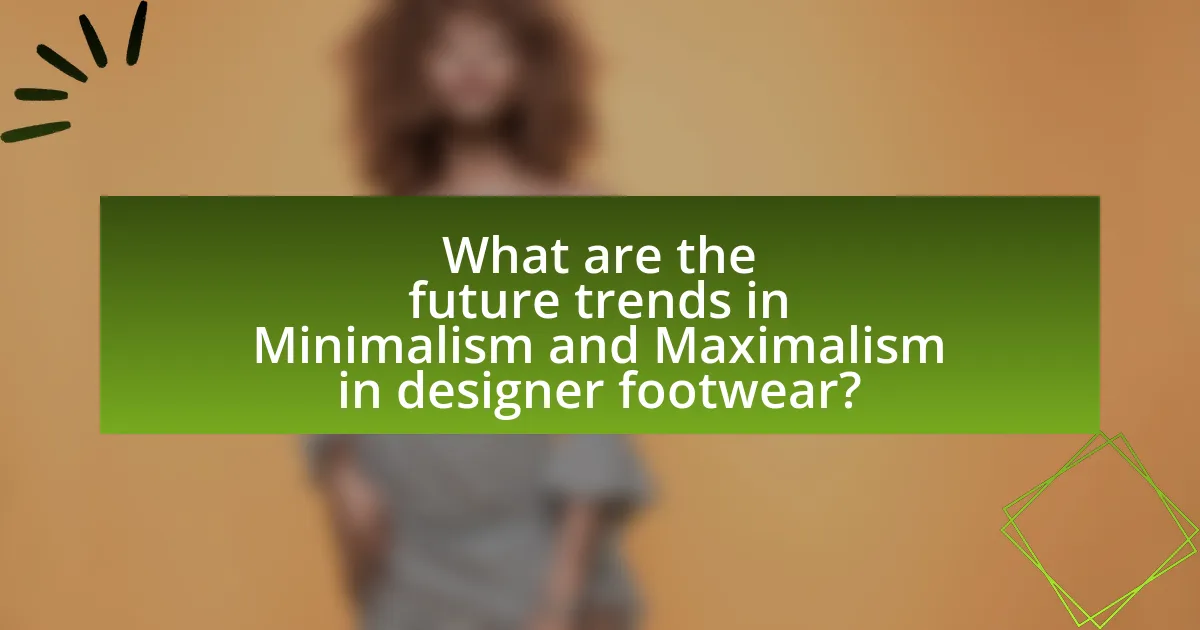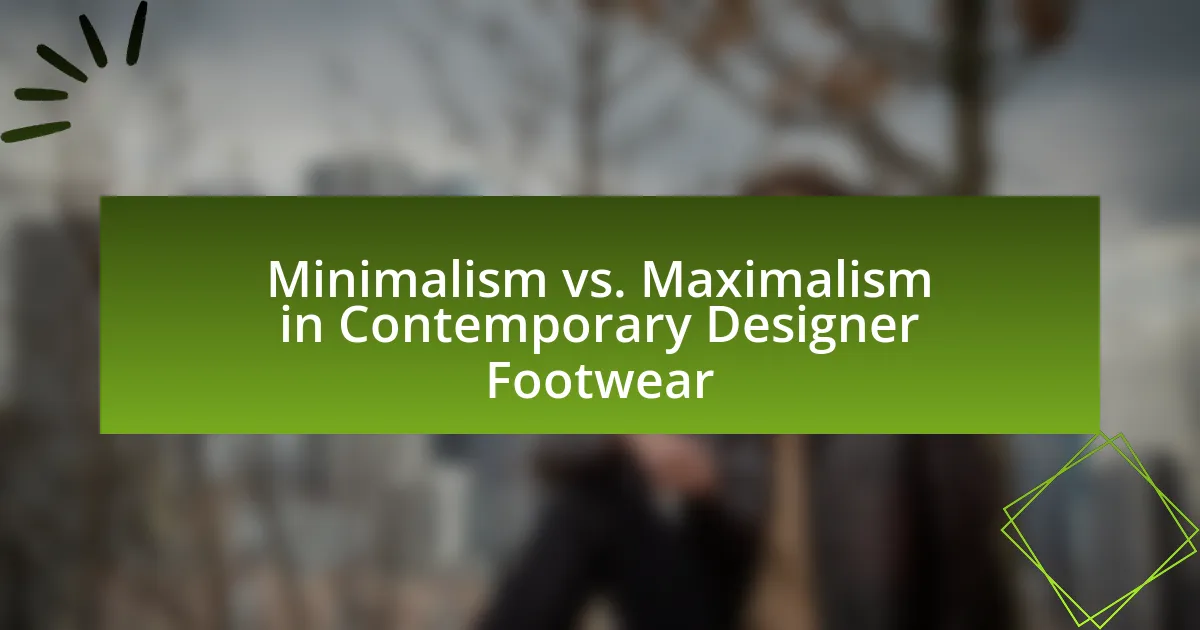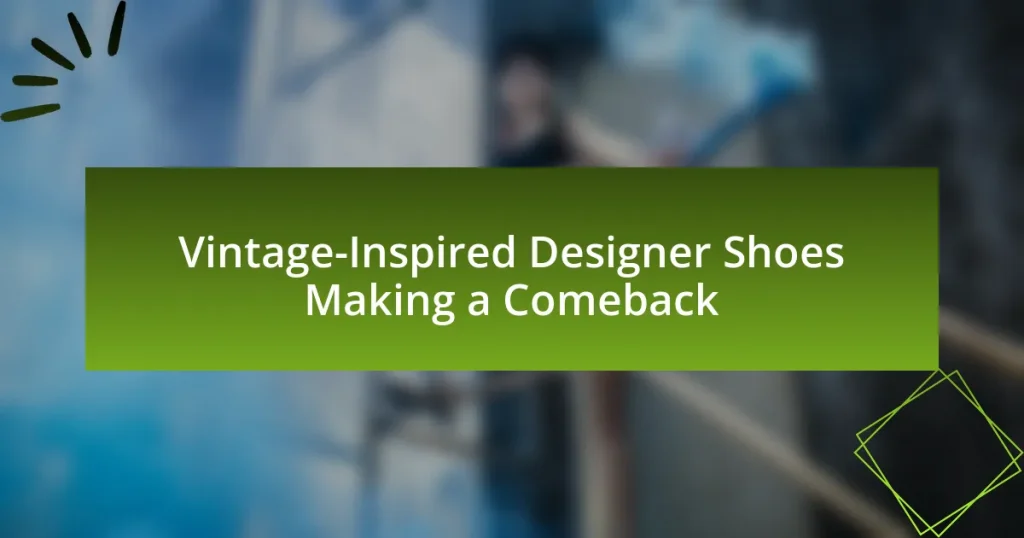The article examines the contrasting design philosophies of Minimalism and Maximalism in contemporary designer footwear. Minimalism is characterized by simplicity, clean lines, and a restrained color palette, focusing on functionality and understated elegance, while Maximalism embraces bold colors, intricate patterns, and elaborate embellishments, celebrating individuality and creativity. Key discussions include the influence of these styles on consumer preferences, the defining features of each approach, and the impact of sustainability on minimalist designs. Additionally, the article explores how lifestyle choices affect footwear selection and the role of technology in evolving maximalist aesthetics.

What are the key differences between Minimalism and Maximalism in Contemporary Designer Footwear?
The key differences between Minimalism and Maximalism in Contemporary Designer Footwear lie in their design philosophies and aesthetic approaches. Minimalism emphasizes simplicity, clean lines, and a restrained color palette, often utilizing high-quality materials to create understated elegance. In contrast, Maximalism embraces bold colors, intricate patterns, and elaborate embellishments, focusing on excess and a more expressive, eclectic style. For example, minimalist footwear brands like Common Projects prioritize functionality and subtlety, while maximalist brands such as Balenciaga often feature exaggerated silhouettes and vibrant designs. This distinction reflects broader trends in fashion, where minimalism is associated with modernity and sophistication, whereas maximalism celebrates individuality and creativity.
How do Minimalist designs influence contemporary footwear trends?
Minimalist designs significantly influence contemporary footwear trends by prioritizing simplicity, functionality, and clean lines. This approach leads to the creation of shoes that emphasize essential features, often resulting in lighter materials and streamlined silhouettes. For instance, brands like Common Projects and Nike’s “Air Force 1” have adopted minimalist aesthetics, focusing on monochromatic color schemes and understated branding, which cater to consumer preferences for versatile and timeless styles. Research indicates that minimalist footwear can enhance comfort and performance, aligning with the growing demand for practical yet stylish options in the market.
What characteristics define Minimalist footwear?
Minimalist footwear is characterized by a lightweight design, minimal cushioning, and a low heel-to-toe drop. These features promote a natural foot movement and enhance ground feel, allowing for better proprioception. The construction often includes flexible materials that enable the foot to move freely, mimicking barefoot conditions. Research indicates that minimalist footwear can improve foot strength and biomechanics, as evidenced by a study published in the Journal of Sports Sciences, which found that runners using minimalist shoes exhibited a more natural gait pattern compared to those in traditional footwear.
How do materials and construction differ in Minimalist designs?
Minimalist designs in contemporary footwear prioritize simplicity and functionality, leading to a distinct choice of materials and construction techniques. These designs often utilize high-quality, lightweight materials such as leather, canvas, or synthetic fibers that emphasize durability while minimizing excess. The construction methods in minimalist footwear focus on streamlined silhouettes and fewer components, often employing techniques like direct injection or cementing to reduce weight and enhance comfort. This contrasts with maximalist designs, which typically incorporate a wider variety of materials and complex constructions, resulting in heavier and more ornate footwear. The emphasis on minimalism is supported by the trend towards sustainability, as fewer materials and simpler construction processes can lead to reduced waste and a lower environmental impact.
What impact does Maximalism have on contemporary footwear styles?
Maximalism significantly influences contemporary footwear styles by promoting bold designs, vibrant colors, and exaggerated proportions. This aesthetic shift encourages brands to experiment with unconventional materials and intricate detailing, resulting in footwear that stands out as a statement piece rather than a subtle accessory. For instance, the rise of chunky sneakers and platform shoes reflects this trend, as seen in collections from designers like Balenciaga and Gucci, which feature oversized silhouettes and eye-catching patterns. The popularity of these styles indicates a consumer preference for individuality and self-expression in fashion, aligning with the broader cultural movement towards maximalism in various design disciplines.
What are the defining features of Maximalist footwear?
Maximalist footwear is characterized by its thick cushioning, bold aesthetics, and exaggerated designs. These shoes often feature oversized soles that provide enhanced comfort and support, catering to those seeking a plush walking experience. Additionally, maximalist footwear typically incorporates vibrant colors, unique patterns, and innovative materials, setting them apart from minimalist styles. The trend has gained popularity due to its emphasis on both functionality and fashion, appealing to consumers who prioritize comfort without sacrificing style.
How do colors and patterns play a role in Maximalist designs?
Colors and patterns are fundamental in Maximalist designs, as they create a vibrant and eclectic aesthetic that defines this style. Maximalism embraces bold color palettes and intricate patterns to evoke emotion and express individuality, contrasting sharply with the simplicity of Minimalism. For instance, the use of clashing colors and diverse motifs can enhance visual interest and create a sense of abundance, which is a hallmark of Maximalist design. This approach is evident in contemporary designer footwear, where brands often incorporate a mix of textures, prints, and hues to attract attention and convey a unique identity.

How do consumer preferences shape Minimalism and Maximalism in footwear?
Consumer preferences significantly influence the trends of Minimalism and Maximalism in footwear by dictating design choices and market demand. For instance, a growing inclination towards sustainability and simplicity has led brands to adopt minimalist designs, characterized by clean lines and fewer embellishments, appealing to consumers seeking functionality and versatility. Conversely, maximalist footwear, which features bold colors, intricate patterns, and exaggerated forms, attracts consumers who prioritize self-expression and individuality. Market research indicates that brands like Balenciaga and Gucci have successfully tapped into these preferences, with Balenciaga’s Triple S sneaker exemplifying maximalism’s popularity through its distinctive silhouette and vibrant aesthetics. This dynamic interplay between consumer preferences and design trends shapes the overall landscape of contemporary footwear, driving brands to adapt their offerings accordingly.
What factors drive consumers towards Minimalist footwear?
Consumers are driven towards Minimalist footwear primarily due to the desire for comfort, simplicity, and functionality. Research indicates that minimalist designs often prioritize lightweight materials and a natural foot position, which can enhance comfort during prolonged wear. Additionally, the aesthetic appeal of minimalist footwear aligns with contemporary trends favoring clean lines and understated elegance, making them versatile for various occasions. Furthermore, the growing awareness of sustainability influences consumer choices, as many minimalist brands emphasize eco-friendly materials and ethical production practices, appealing to environmentally conscious shoppers.
How does lifestyle influence the choice of Minimalist designs?
Lifestyle significantly influences the choice of Minimalist designs by prioritizing simplicity, functionality, and sustainability. Individuals who lead fast-paced, urban lifestyles often seek designs that reduce clutter and enhance efficiency, aligning with Minimalism’s core principles. For instance, research indicates that consumers increasingly prefer products that offer versatility and ease of use, which are hallmarks of Minimalist design. A study by the Journal of Consumer Research found that 60% of consumers are drawn to brands that emphasize minimalistic aesthetics, as these designs resonate with their desire for a streamlined, stress-free life. This trend reflects a broader cultural shift towards valuing experiences over possessions, further solidifying Minimalism’s appeal in contemporary designer footwear.
What are the perceived benefits of wearing Minimalist footwear?
Wearing Minimalist footwear is perceived to enhance natural foot movement and improve overall foot health. This type of footwear typically features a lightweight design, a flexible sole, and minimal cushioning, which allows for a more natural gait and better proprioception. Research indicates that minimalist shoes can strengthen foot muscles and improve balance, as they encourage the foot to engage more actively during movement. A study published in the Journal of Foot and Ankle Research found that participants who transitioned to minimalist footwear reported reduced foot pain and improved foot function over time.
Why do some consumers prefer Maximalist footwear styles?
Some consumers prefer Maximalist footwear styles due to their emphasis on bold aesthetics and comfort. This preference is driven by the desire for self-expression and individuality, as Maximalist designs often feature vibrant colors, exaggerated shapes, and unique patterns that stand out. Additionally, the cushioning and support provided by these styles cater to consumers seeking comfort in their footwear, aligning with trends that prioritize both style and functionality. Research indicates that the rise of athleisure and casual wear has further fueled the popularity of Maximalist footwear, as consumers increasingly value versatile options that can transition from casual to more formal settings.
What emotional responses do Maximalist designs evoke in consumers?
Maximalist designs evoke feelings of excitement, joy, and nostalgia in consumers. These designs often feature bold colors, intricate patterns, and a mix of textures, which stimulate visual engagement and create a sense of vibrancy. Research indicates that consumers are drawn to maximalist aesthetics because they can evoke personal memories and cultural references, enhancing emotional connections to the products. For instance, a study published in the Journal of Consumer Research found that consumers often associate maximalist designs with positive emotional experiences, leading to increased brand loyalty and purchase intent.
How does brand identity affect consumer choices in Maximalism?
Brand identity significantly influences consumer choices in Maximalism by creating a strong emotional connection and perceived value. Consumers are drawn to brands that embody bold aesthetics, vibrant colors, and intricate designs, which are hallmarks of Maximalist fashion. For instance, brands like Gucci and Versace leverage their distinct identities to attract consumers who seek self-expression and individuality through extravagant styles. Research indicates that 60% of consumers are more likely to purchase from brands that resonate with their personal identity, highlighting the importance of brand identity in shaping preferences within the Maximalist segment.

What are the future trends in Minimalism and Maximalism in designer footwear?
Future trends in Minimalism and Maximalism in designer footwear indicate a growing divergence, with minimalism focusing on sustainability and functionality, while maximalism embraces bold aesthetics and personalization. Minimalist footwear is increasingly incorporating eco-friendly materials and streamlined designs, reflecting consumer demand for sustainable fashion; for instance, brands like Allbirds and Veja are leading this trend by using recycled materials. Conversely, maximalist footwear is gaining traction through vibrant colors, exaggerated silhouettes, and unique embellishments, as seen in collections from designers like Balenciaga and Gucci, which cater to consumers seeking self-expression and individuality. This duality in trends suggests that the footwear market will continue to evolve, balancing the minimalist pursuit of simplicity with the maximalist celebration of creativity.
How are sustainability concerns influencing Minimalist footwear trends?
Sustainability concerns are significantly influencing Minimalist footwear trends by driving brands to adopt eco-friendly materials and production methods. As consumers increasingly prioritize environmental impact, footwear companies are responding by utilizing sustainable materials such as recycled plastics, organic cotton, and biodegradable components. For instance, a report from the Global Fashion Agenda indicates that 66% of consumers are willing to pay more for sustainable brands, prompting minimalist footwear designers to focus on durability and timeless designs that reduce waste. This shift not only aligns with consumer values but also encourages innovation in sustainable practices within the footwear industry.
What innovations are emerging in sustainable Minimalist designs?
Innovations in sustainable minimalist designs include the use of biodegradable materials, modular construction techniques, and zero-waste production methods. Biodegradable materials, such as mycelium and organic cotton, reduce environmental impact by decomposing naturally. Modular construction allows for easy repair and customization, extending the lifespan of products. Zero-waste production techniques minimize fabric waste during manufacturing, aligning with sustainability goals. These innovations reflect a growing trend in the fashion industry towards eco-friendly practices while maintaining minimalist aesthetics.
How do consumer demands for eco-friendly materials shape the market?
Consumer demands for eco-friendly materials significantly shape the market by driving brands to adopt sustainable practices and innovate product offerings. As consumers increasingly prioritize environmental responsibility, companies in the footwear industry are compelled to source materials like organic cotton, recycled plastics, and biodegradable components. For instance, a 2021 survey by McKinsey & Company found that 67% of consumers consider sustainability when making a purchase, prompting brands to integrate eco-friendly materials into their designs to meet this demand. This shift not only influences product development but also affects pricing strategies and marketing approaches, as brands highlight their commitment to sustainability to attract environmentally conscious consumers.
What new directions are Maximalist designs taking in contemporary footwear?
Maximalist designs in contemporary footwear are increasingly embracing bold colors, exaggerated proportions, and intricate detailing. This shift reflects a growing consumer desire for individuality and self-expression, moving away from the understated aesthetics of minimalism. Brands like Balenciaga and Gucci have pioneered this trend by incorporating oversized silhouettes and vibrant patterns, which cater to a market that values statement pieces. The rise of social media platforms has further amplified this direction, as visually striking footwear garners attention and engagement, reinforcing the trend’s popularity.
How are cultural influences reshaping Maximalist footwear aesthetics?
Cultural influences are reshaping Maximalist footwear aesthetics by integrating diverse artistic expressions, historical references, and global fashion trends. For instance, the resurgence of bold colors and exaggerated silhouettes in footwear reflects a blend of streetwear culture and high fashion, driven by social media platforms that amplify visual storytelling. Additionally, collaborations between designers and artists from various cultural backgrounds have introduced unique patterns and textures, further diversifying the aesthetic landscape. This evolution is evidenced by brands like Balenciaga and Gucci, which have embraced eclectic designs that challenge traditional norms, showcasing how cultural narratives can redefine footwear aesthetics.
What role does technology play in the evolution of Maximalist designs?
Technology significantly enhances the evolution of Maximalist designs by enabling innovative materials and production techniques. Advanced manufacturing processes, such as 3D printing and digital fabrication, allow designers to create intricate patterns and textures that define Maximalism. For instance, the use of lightweight, high-performance materials facilitates bold shapes and vibrant color combinations, which are hallmarks of Maximalist aesthetics. Additionally, technology in design software enables greater experimentation with form and structure, leading to unique and expressive footwear designs. This integration of technology not only expands creative possibilities but also meets consumer demand for personalized and statement-making footwear.
What practical tips can consumers consider when choosing between Minimalist and Maximalist footwear?
Consumers should consider their lifestyle and comfort preferences when choosing between Minimalist and Maximalist footwear. Minimalist footwear typically offers a lightweight design and promotes natural foot movement, making it suitable for activities like running or casual wear. In contrast, Maximalist footwear provides extra cushioning and support, which can be beneficial for individuals who require more shock absorption during high-impact activities or long periods of standing. Additionally, consumers should assess the fit and arch support of each style, as these factors significantly impact comfort and performance. Research indicates that proper footwear can reduce the risk of injury, highlighting the importance of selecting shoes that align with individual foot mechanics and activity levels.
How can one assess personal style preferences when selecting footwear?
To assess personal style preferences when selecting footwear, individuals should evaluate their lifestyle, wardrobe, and aesthetic inclinations. This involves analyzing the types of clothing they own, the occasions they dress for, and their comfort with various styles, such as minimalist designs characterized by simplicity and clean lines or maximalist options that embrace bold patterns and embellishments. Research indicates that personal style is often influenced by factors such as cultural background and social environment, which can guide footwear choices that align with one’s identity and self-expression.
What factors should be considered for comfort and functionality in both styles?
Comfort and functionality in both minimalism and maximalism in contemporary designer footwear should consider materials, fit, and support. High-quality materials enhance breathability and durability, which are essential for comfort. The fit must accommodate various foot shapes to prevent discomfort during wear, while adequate support, such as arch and cushioning, is crucial for functionality, especially in prolonged use. Studies show that footwear with proper arch support can reduce foot fatigue and improve overall comfort, validating the importance of these factors in both design styles.



